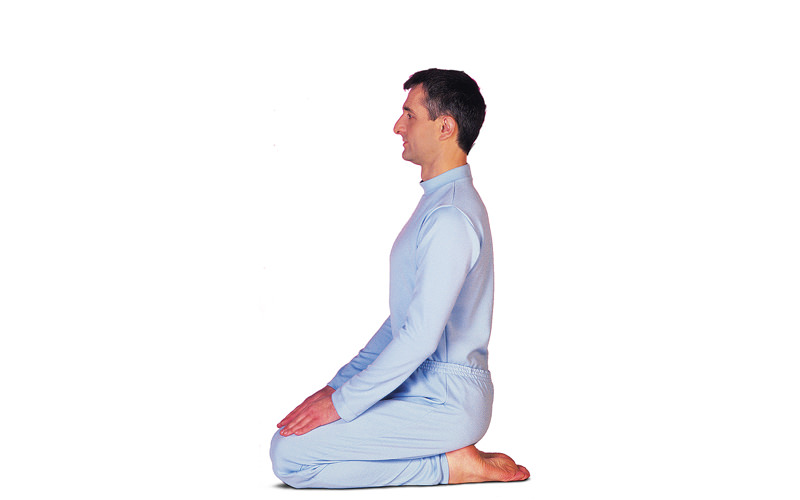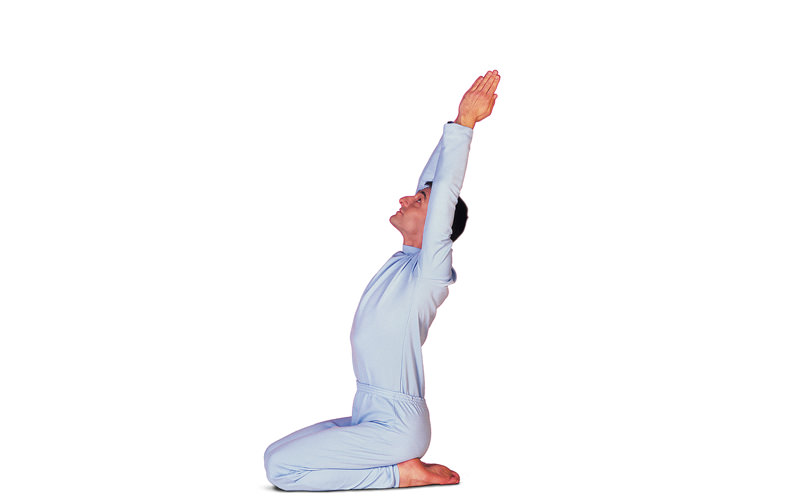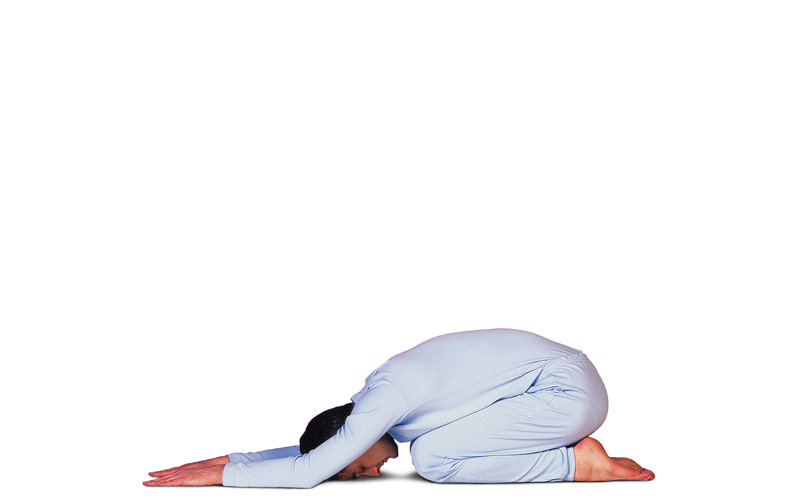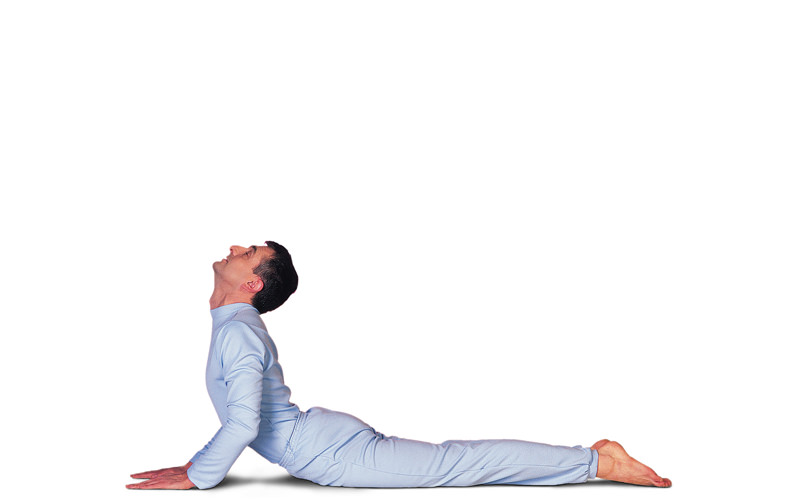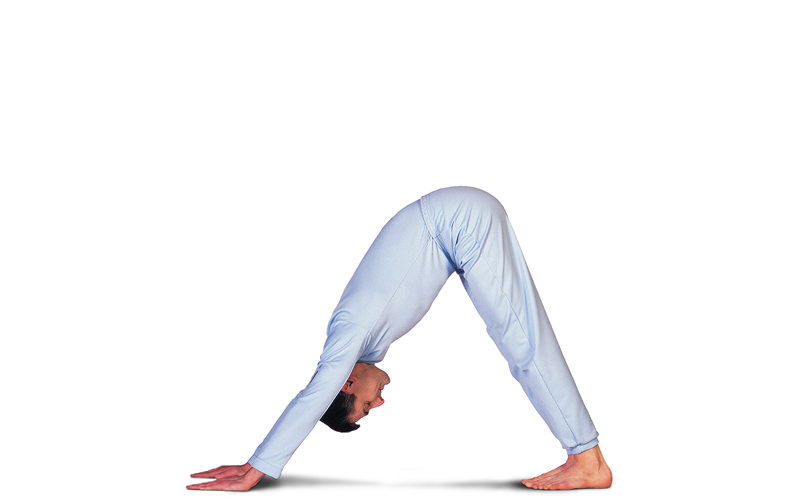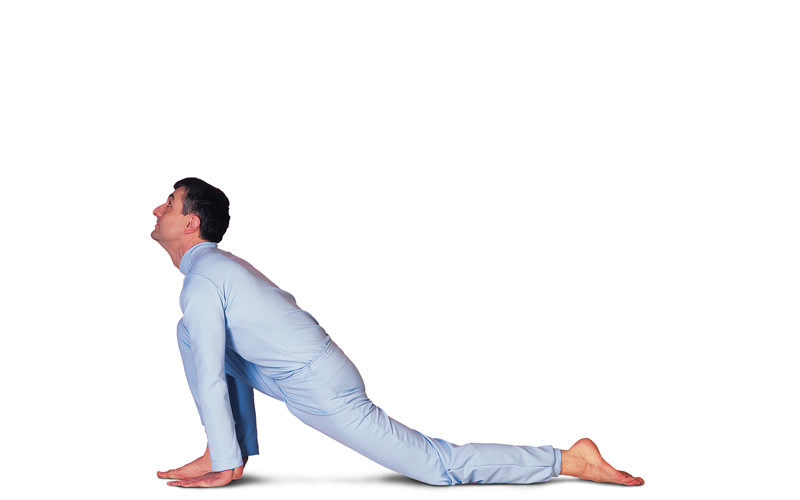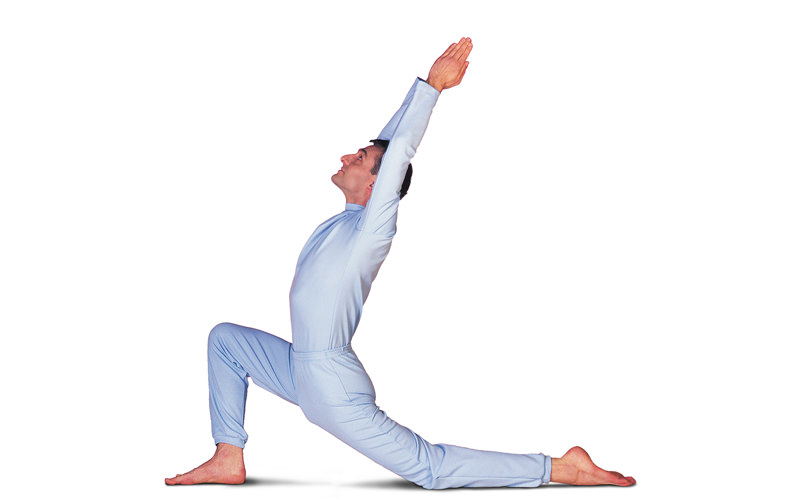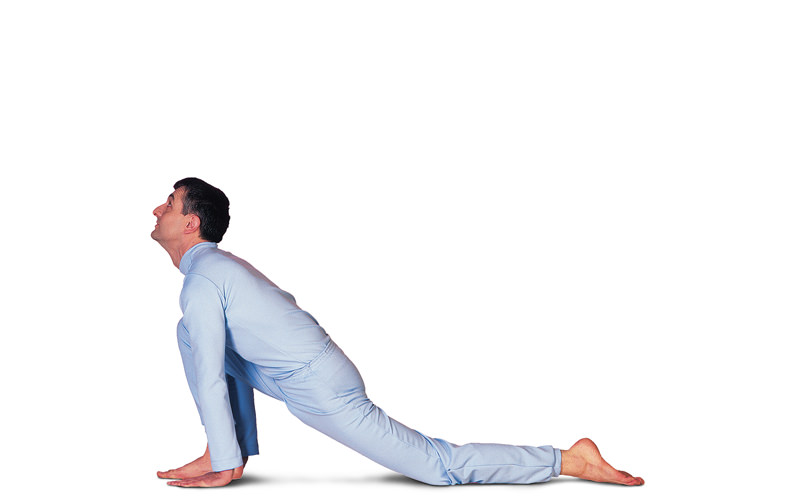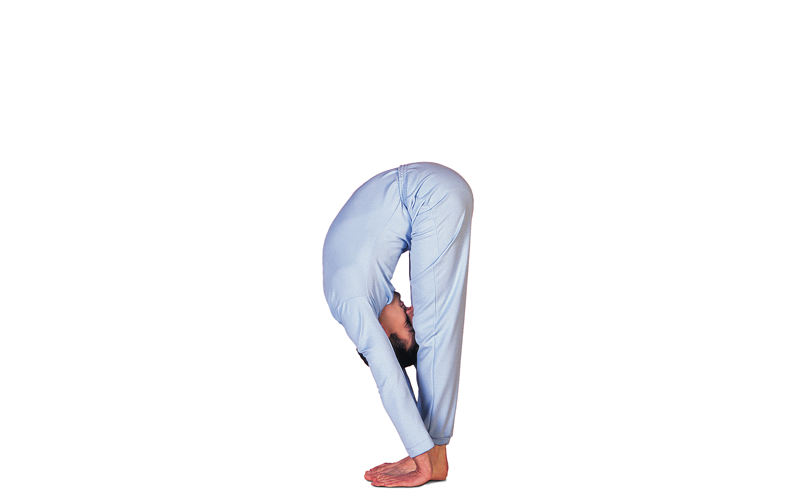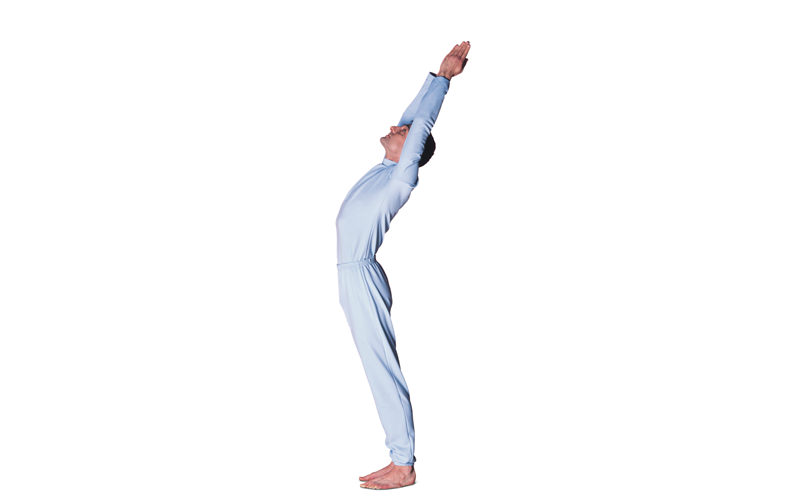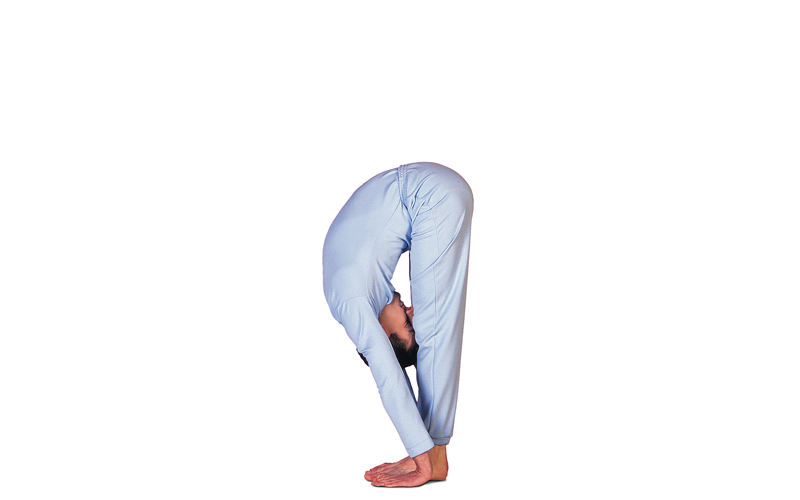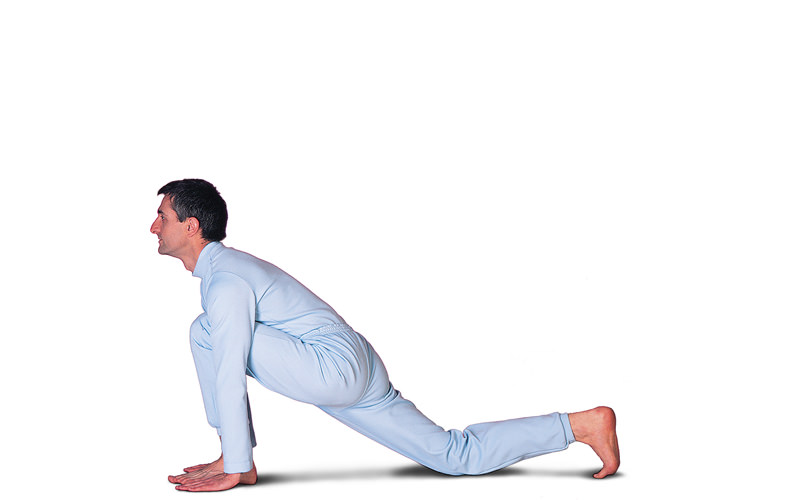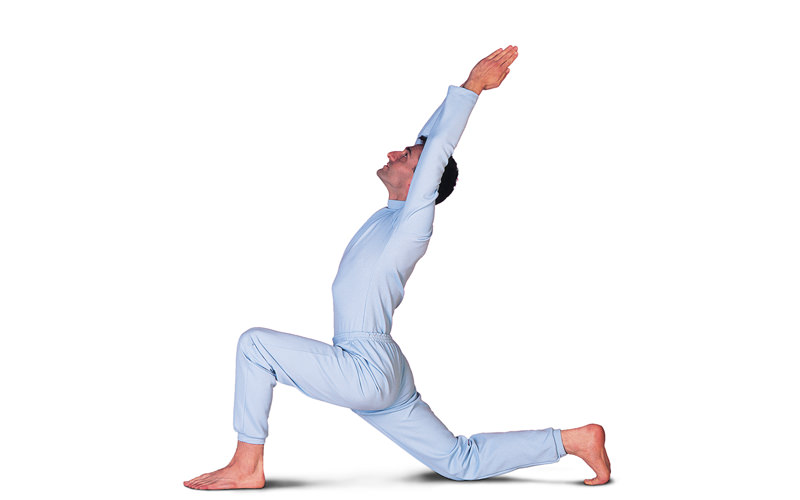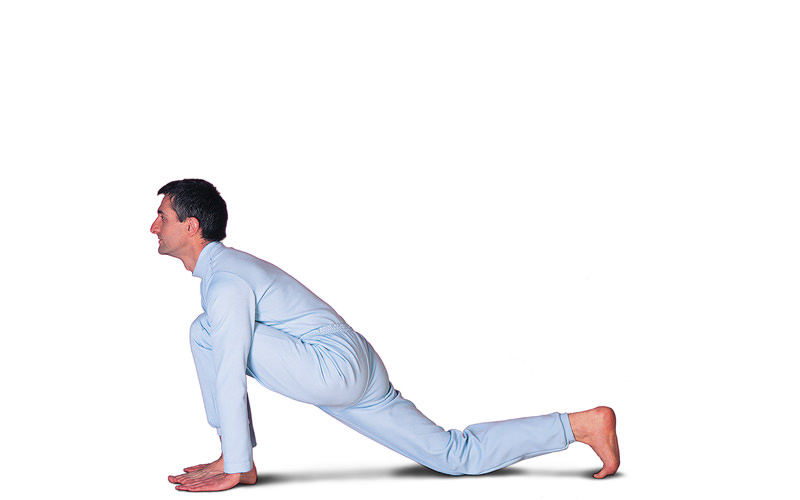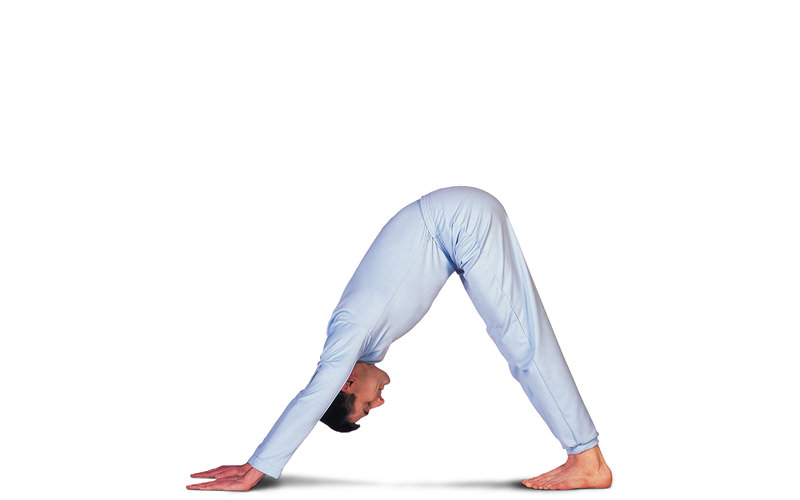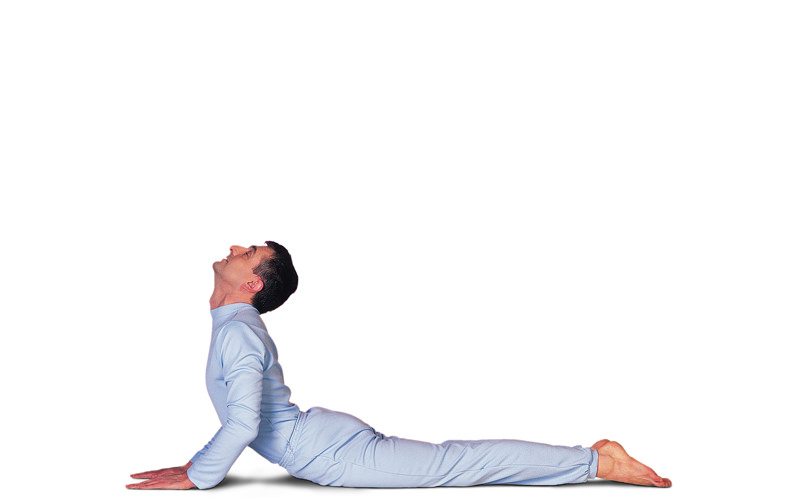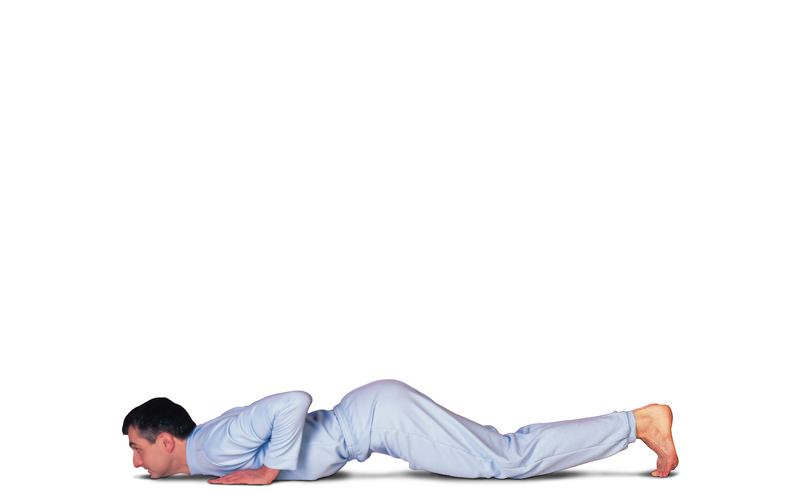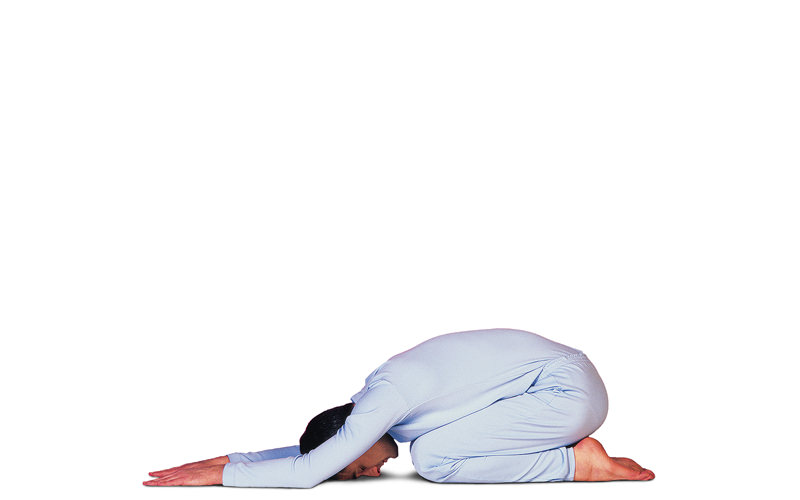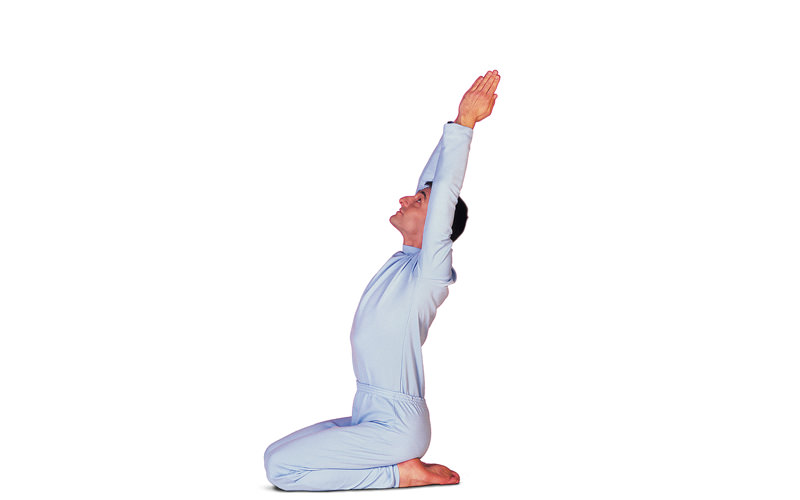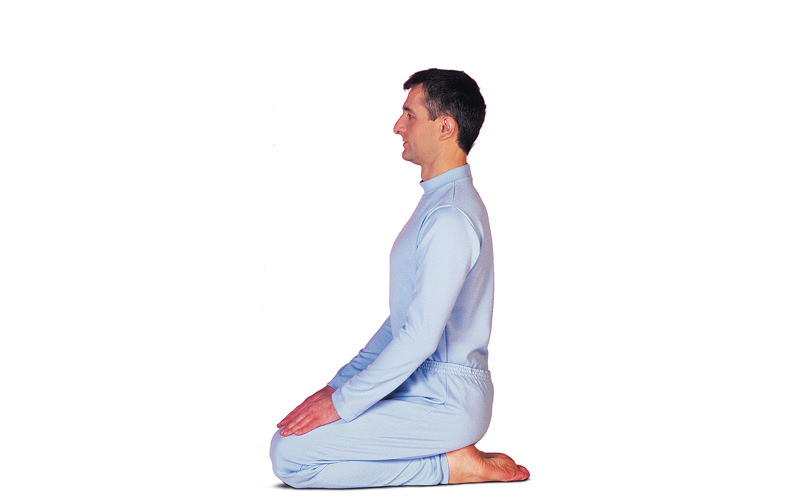Starting Position:
Vajrasana
Concentration:
on the whole body
Breath:
coordinated with movement
Repetitions:
4-6 times
This exercise balances and harmonizes body, mind and soul in a perfect way.
On a physical level it strengthens, stretches and relaxes the muscles, ligaments and joints of the whole body. It expands the lungs and deepens the breath so energy can flow more freely throughout the body. Circulation is stimulated and fatigue is overcome. Because more blood is supplied to the head, there is an improvement in concentration and eyesight. Khatu Pranam also makes the spine more flexible and promotes healthy function of organs and glands. If one practices these exercises with regular discipline, Khatu Pranam also becomes a powerful tool in regulating the entire nervous system. One can balance strong emotions and overcome nervousness and depression.
On a spiritual level, Khatu Pranam is like a cosmic dance or Mudra (spiritual expression). It has a strong influence on our energy centres (Chakras) and the life energy (Prana) flows better throughout the whole body. The Tattvas (elements) and biorhythms are brought into balance. It expands consciousness, harmonises the body, breath and nervous system, and promotes the feeling of calmness. It broadens the consciousness to perceive the vital energy existing everywhere.
Perform 4-6 rounds of Khatu Pranam once or twice a day, especially when feeling tired and you will feel fresh and vital.
Practice:
Sit in Vajrasana. The body is erect, hands rest on the thighs. Back, neck and head form a straight line. Relax the whole body.
-
Inhaling raise both arms above the head. Place the palms together and stretch a little higher and slightly back. Look towards the hands.
-
Exhaling turn the palms to the front. Keeping the back and arms straight, bend forward from the hips until the arms and forehead touch the floor (Shashankasana).
-
Inhaling bring the upper body forward along the floor until the shoulders are between the hands, the toes are tucked under. Chin, chest, knees and toes touch the floor. The buttocks are slightly raised.
-
Holding the breath lower the hips to the floor and with the help of the hands lift the body up (Bhujangasana). The shoulders are pressed down and back. Stretch not only through the lumbar spine but also through the thoracic spine, so that the whole of the spine is evenly arched. The feet rest flat on the floor. Straighten the arms only to the degree that the hips can remain in contact with the floor. Look up.
-
Exhaling tuck the toes under, straighten the arms and legs and raise the buttocks high. Bring the heels to the floor, so the whole of the foot contacts the floor. Upper body and arms form a line and the head hangs relaxed between the straight arms. Body weight is distributed between the hands and the soles of the feet. Gaze is directed towards the navel.
-
Inhaling step the right foot between the hands and lower the left knee to the floor. The toes of the left foot can be tucked under or lie flat on the floor. Raise the head and look up. The palms or fingers touch the floor. The right side of the abdomen and chest rest on the right thigh.
-
Holding the breath extend the arms above the head and bring the palms together. Stretch the whole body up and slightly back. Look towards the hands.
-
Exhaling return to Position 6.
-
Holding the breath bring the left foot beside the right and straighten the knees. Allow the upper body to hang forward completely relaxed. If it is possible, place the palms of the hands on the floor.
-
Inhaling raise the body with the arms extended above the head. Bring the palms together and stretch the whole body up and slightly back. Look towards the hands. The back is evenly extended.
-
The Asanas now continue in reverse order.
-
Exhaling bend forward again and allow the upper body to hang, as in Position 9.
-
Inhaling step back with the right foot, lower the right knee to the floor and look up, as in Position 6.
-
Holding the breath raise the arms as in Position 7.
-
Exhaling lower the arms and place the hands beside the foot on the floor, as in Position 6 or 12.
-
Holding the breath step the left foot back beside the right foot and raise the buttocks high as in Position 5.
-
Inhaling lower the hips to the floor and come into Bhujangasana, as in Position 4.
-
Exhaling place chin and chest on the floor and raise the buttocks, as in Position 3.
-
Holding the breath pull the upper body back into Shashankasana as in Position 2.
-
Inhaling raise the body with arms above the head and place the palms together as in Position 1.
-
Exhaling lower the arms and return to the starting position.
-
In the second round step the left foot forward between the hands in Position 6 and back again in Position 12. In the third round, step the right foot forward again in Position 6, etc.
-
The postures of this exercise sequence can also be performed as individual Asanas. To practice in this way hold each position for some time with normal breathing.
Khatu Pranam Mantras
-
Position 1
ॐ असतो मा सद्गमय
om asato mā sad gamaya
OM Lead us from unreality to reality
-
Position 2
ॐ तमसो मा ज्योतिर्गमय
om tamaso mā jyotir gamaya
OM Lead us from darkness to light
-
Position 3
ॐ मृत्योर्मामृतं गमय
om mṛtyor mā amṛtam gamaya
OM Lead us from death to immortality
-
Position 4
ॐ सर्वेषां स्वस्तिर्भवतु
om sarveṣām svastir bhavatu
OM May everywhere be good health
-
Position 5
ॐ सर्वेषां शान्तिर्भवतु
om sarveṣām śāntir bhavatu
OM May everywhere be peace
-
Position 6
ॐ सर्वेषां मङ्गलं भवतु
om sarveṣām maṅgalam bhavatu
OM May everywhere be harmony
-
Position 7
ॐ सर्वेषां पूर्णं भवतु
om sarveṣām pūrṇam bhavatu
OM May all realize completeness
-
Position 8
ॐ लोकाः समस्ताः सुखिनो भवन्तु
om lokaḥ samastāḥ sukhino bhavantu
OM May there be happiness and prosperity on all planes
-
Position 9
ॐ द्यौः शान्तिः
om dhyauḥ śāntiḥ
OM Peace be in the universe
-
Position 10
ॐ अन्तरिक्षं शान्तिः
om antarikṣam śāntiḥ
OM Peace be in the atmosphere
-
Position 11
ॐ पृथिवी शान्तिः
om pṛthivī śāntiḥ
OM Peace be on earth
-
Position 12
ॐ आपः शान्तिः
om āpaḥ śāntiḥ
OM Peace be in the waters
-
Position 13
ॐ ओषधयः शान्तिः
om oṣadhayaḥ śāntiḥ
OM Peace be in the herbs and fruits
-
Position 14
ॐ वनस्पतय: शान्तिः
om vanaspatayaḥ śāntiḥ
OM Peace be in the plants and trees
-
Position 15
ॐ विश्वेदेवाः शान्तिः
om viśve devāḥ śāntiḥ
OM Peace be in the elements
-
Position 16
ॐ ब्रह्म शान्तिः
om brahma śāntiḥ
OM Peace be of the Supreme
-
Position 17
ॐ सर्वं शान्तिः
om sarvam śāntiḥ
OM Peace be everywhere
-
Position 18
ॐ शान्तिरेव शान्तिः
om śāntir eva śāntiḥ
OM Peace, only peace
-
Position 19
ॐ सा मा शान्तिरेधि
om sā mā śāntiredhi
OM Peace be in my mind and heart
-
Position 20
ॐ शान्तिः शान्तिः शान्तिः
om śāntiḥ śāntiḥ śāntiḥ
OM Peace, Peace, Peace
Benefits:
-
Position 1 + 19
Stretches all the muscles, ligaments and joints of the upper body and relaxes the organs of the abdomen and chest. The lungs are expanded and the breath spreads into all areas of the chest, particularly into the sides of the lungs. The energy flows more freely throughout the body, especially into the limbs. This posture influences the Vishuddhi Chakra.
-
Position 2 + 18
The increased blood supply to the head promotes concentration. The Asana has a calming effect and relieves tiredness, nervousness and depression. It relaxes the neck and shoulders, deepens the breath into the back and releases tension in the back. The pressure of the thigh and the movement of the breath into the abdomen massages the intestines. This posture influences the Muladhara Chakra (especially when practiced with Ashvini Mudra).
-
Position 3 + 17
Stretches the entire spine and counters a rounded back. The posture relaxes the pelvic region and is of benefit to the organs of the lower abdomen. Deep, diaphragmatic breathing is promoted which stimulates the flow of energy throughout the whole body.
-
Position 4 + 16
Stretches the whole spine and front of the body. Stimulates the flow of energy and increases the flow of the breath into the sides of the lungs. Circulates blood to all organs of the pelvis, abdomen and chest, and stimulates function of all glands. The position calms strong emotions. Strengthens the back, arm and shoulder muscles. Extends the spine and stretches the hip flexors, thus is excellent in preventing a rounded back. For this reason, this Asana is recommended for those with sitting professions. The Asana has a balancing influence on the Svadhishthana Chakra.
-
Position 5 + 15
Strengthens the whole body. Stimulates blood circulation and particularly increases the flow of blood into the head. In this way the Asana counters tiredness and aids concentration and eyesight. Stretches the calf muscles and helps foot strain and venous return. This posture balances the energy flow of the whole body and has an activating effect upon the Sahasrara Chakra.
-
Position 6 + 14
Extends the back and stretches the muscles of the hips and pelvic floor. Promotes good posture. The Asana develops deeper breathing and healthy digestion. This posture influences the Anahata Chakra.
-
Position 7 + 13
Stretches the whole of the upper body, especially along the sides of the chest. The chest is opened and expanded, allowing the breath to flow evenly into all areas of the lungs. Improves balance and leg stability. Extends the back and stretches the hips, promoting good posture and a relaxed meditation pose. The Asana influences the Vishuddhi Chakra.
-
Position 8 + 12 (as for 6 + 14)
-
Position 9 + 11
The upper body can relax in this position. All joints of the spine, shoulders and arms are relieved of strain and receive an increased supply of blood. Stimulates the function of all internal organs and muscles, as well as the sense organs in the head (eyes, ears etc.). Stretches the back muscles and the muscles of the legs. This Asana activates the Manipura Chakra.
-
Position 10
Invigorates the whole body, balances energy flow and stimulates the function of all glands. Deepens the breath, stimulates digestion and helps relieve diseases of the throat. The posture has a balancing effect upon the Vishuddhi Chakra.
Caution:
Avoid this sequence of Asanas with very high blood pressure or dizziness.
Asana is included in the following categories:
Asanas and Exercises to Increase Flexibility of the Spine
Asanas and Exercises to Stimulate Circulation
Asanas and Exercises for Low Blood Pressure
Asanas and Exercises to Activate the Whole Body
Asanas and Exercises to Calm and Balance the Nervous System
Asanas and Exercises to Improve Concentration
Asanas and Exercises for Depression
